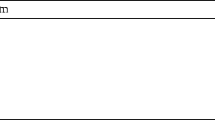Abstract
This paper presents a solution method for the general (mixed integer) parametric linear complementarity problem pLCP(q(θ),M), where the matrix M has a general structure and integrality restriction can be enforced on the solution. Based on the equivalence between the linear complementarity problem and mixed integer feasibility problem, we propose a mixed integer programming formulation with an objective of finding the minimum 1-norm solution for the original linear complementarity problem. The parametric linear complementarity problem is then formulated as multiparametric mixed integer programming problem, which is solved using a multiparametric programming algorithm. The proposed method is illustrated through a number of examples.
Similar content being viewed by others
References
Chandrasekaran, R., Kabadi, S. N., & Sridhar, R. (1998). Integer solution for linear complementarity problem. Mathematics of Operations Research, 23, 390–402.
Cottle, R. W. (1972). Monotone solutions of the parametric linear complementarity problem. Mathematical Programming, 3, 210–224.
Cottle, R. W., Pang, J. S., & Stone, R. E. (1992). The linear complementarity problem. San Diego: Academic Press.
Danao, R. A. (1997). On the parametric linear complementarity problem. Journal of Optimization Theory and Applications, 95, 445–454.
Dua, V., & Pistikopoulos, E. N. (2000). An algorithm for the solution of multiparametric mixed integer linear programming problems. Annals of Operation Research, 99, 123–139.
Eaves, B. C. (1976). A finite algorithm for the linear exchange model. Journal of Mathematical Economics, 3, 197–203.
Ferris, M. C., & Pang, J. S. (1997). Engineering and economic applications of complementarity problems. SIAM Review, 39, 669–713.
Gailly, B., Installe, M., & Smeers, Y. (2001). A new resolution method for the parametric linear complementarity problem. European Journal of Operational Research, 128, 639–646.
Jones, C. N., & Morrari, M. (2006). Multiparametric linear complementarity problems. In 45th IEEE conference on decision and control (pp. 5687–5692).
Kaneko, I. (1977). Isotone solutions of parametric linear complementarity problems. Mathematical Programming, 12, 48–59.
Li, Z., & Ierapetritou, M. G. (2007). Process scheduling under uncertainty using multiparametric programming. AIChE Journal, 53, 3183–3203.
Maier, G. (1972). Problem—on parametric linear complementarity problems. SIAM Review, 14, 364–365.
Martin, R. K. (1999). Large scale linear and integer optimization: a unified approach. Norwell: Kluwer Academic.
Megiddo, N. (1977). On monotonicity in parametric linear complementarity problems. Mathematical Programming, 12, 60–66.
Murty, K. G. (1971). On the parametric complementarity problem. In Engineering summer conference notes. University of Michigan.
Pardalos, P. M., & Nagurney, A. (1990). The integer linear complementarity problem. International Journal of Computer Mathematics, 31, 205–214.
Pardalos, P. M., & Rosen, J. B. (1988). Global optimization approach to the linear complementarity problem. SIAM Journal on Scientific and Statistical Computing, 9, 341–353.
Rosen, J. B. (1990). Minimum norm solution to the linear complementarity problem. In Functional analysis, optimization, and mathematical economics. London: Oxford University Press.
Tammer, K. (1998). Parametric linear complementarity problems. In A. V. Fiacco (Ed.), Mathematical programming with data perturbations (pp. 399–415). Boca Raton: CRC Press.
Tondel, P., Johansen, T., & Bemporad, A. (2003). An algorithm for multi-parametric quadratic programming and explicit MPC solutions. Automatica, 39, 489–497.
Author information
Authors and Affiliations
Corresponding author
Rights and permissions
About this article
Cite this article
Li, Z., Ierapetritou, M.G. A method for solving the general parametric linear complementarity problem. Ann Oper Res 181, 485–501 (2010). https://doi.org/10.1007/s10479-010-0770-6
Published:
Issue Date:
DOI: https://doi.org/10.1007/s10479-010-0770-6




